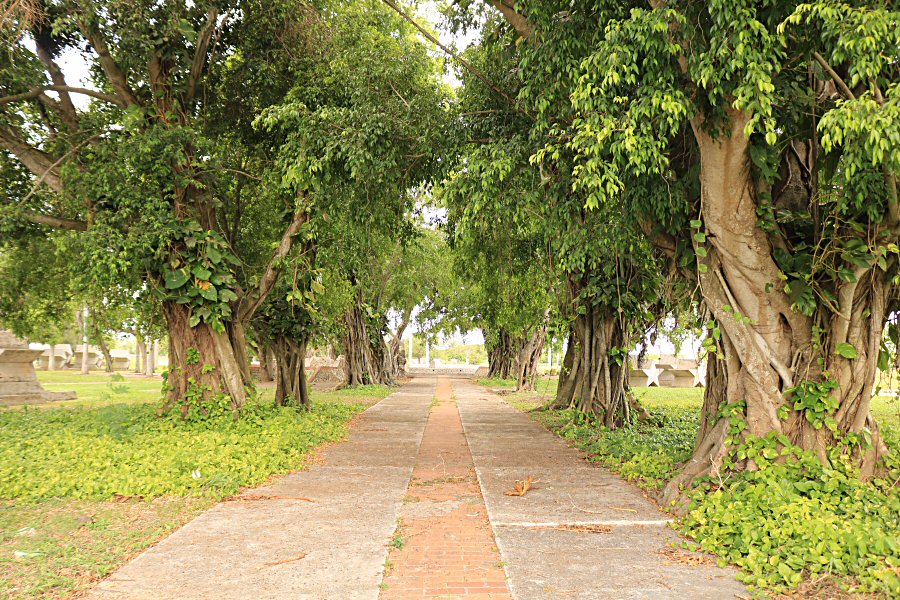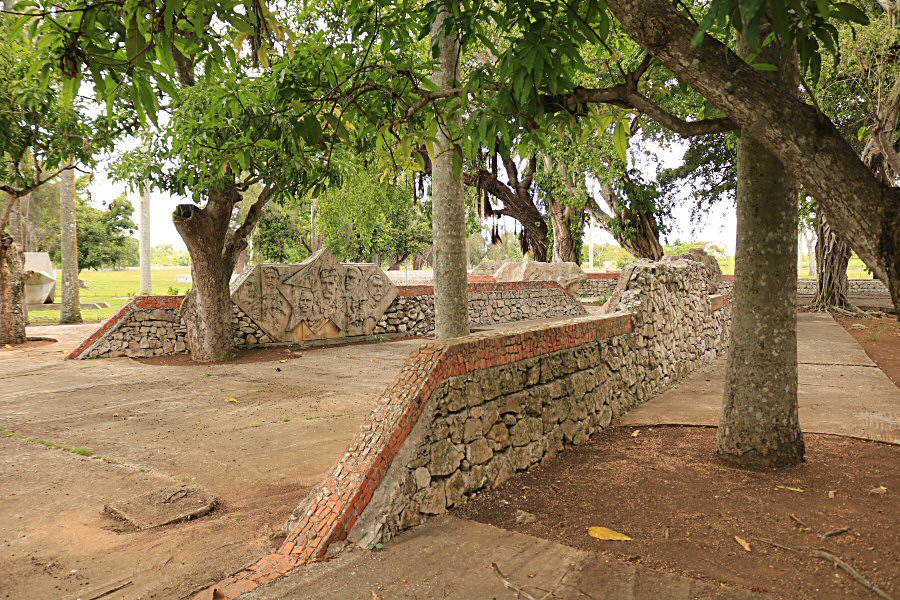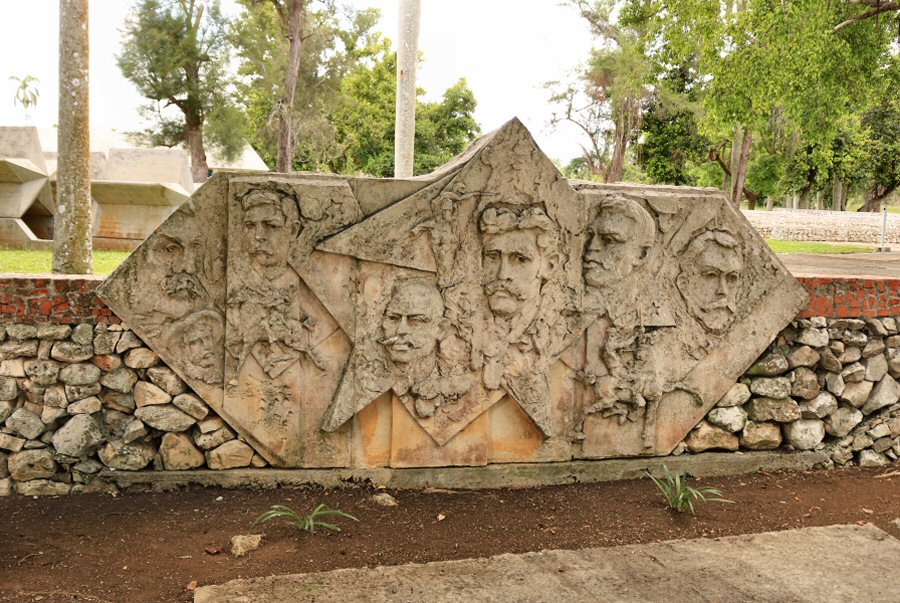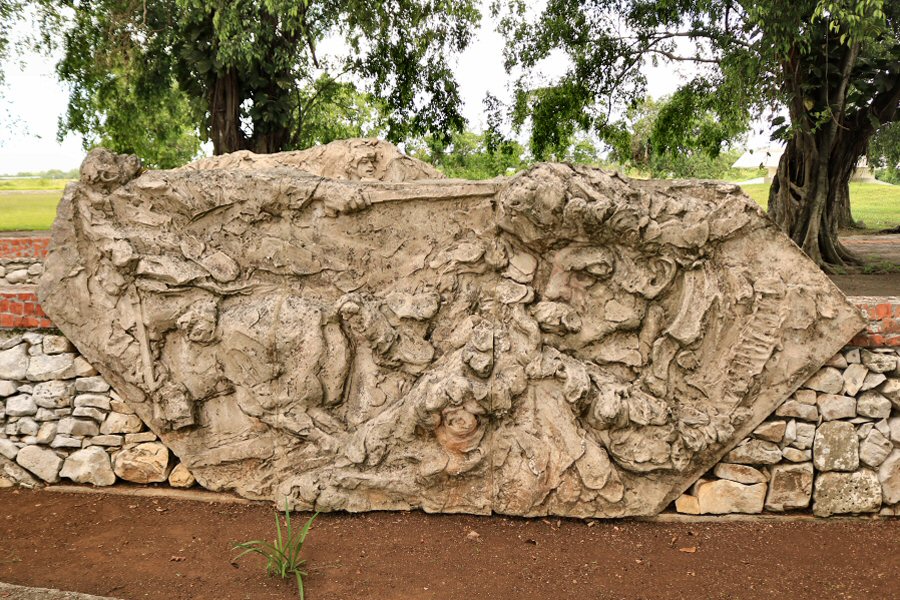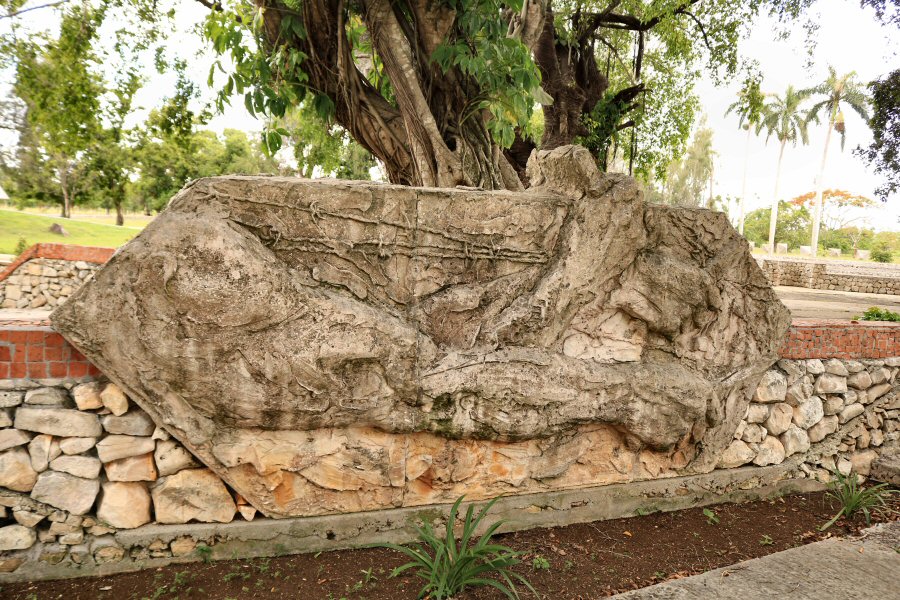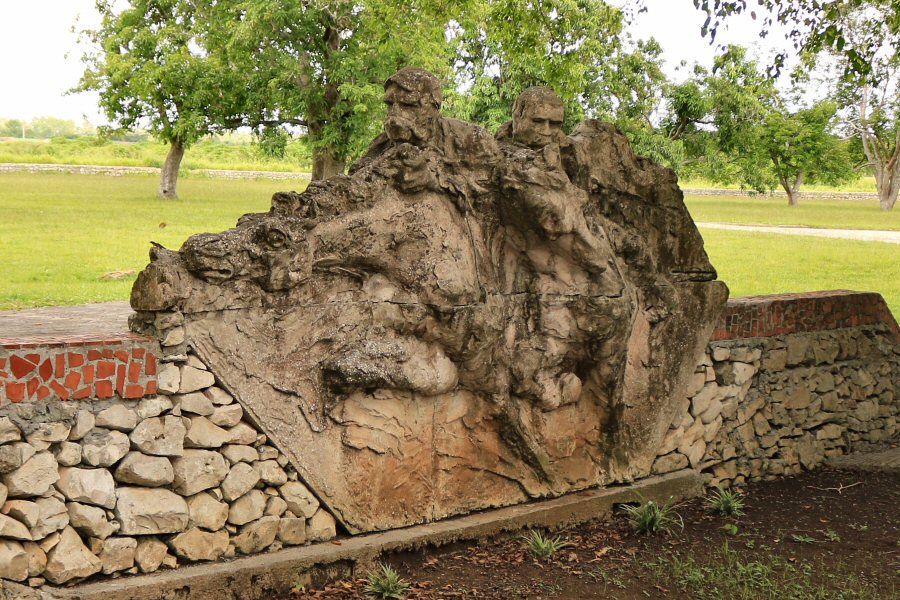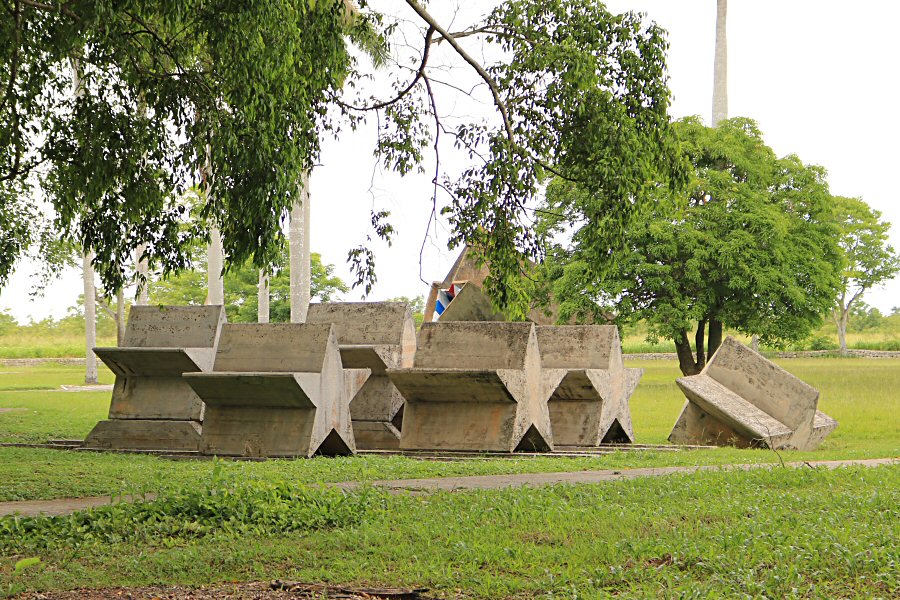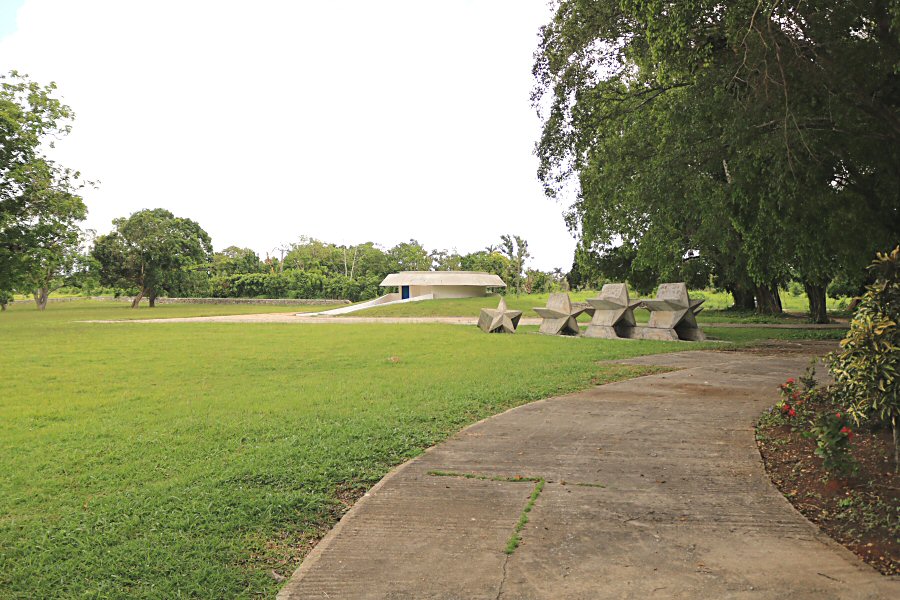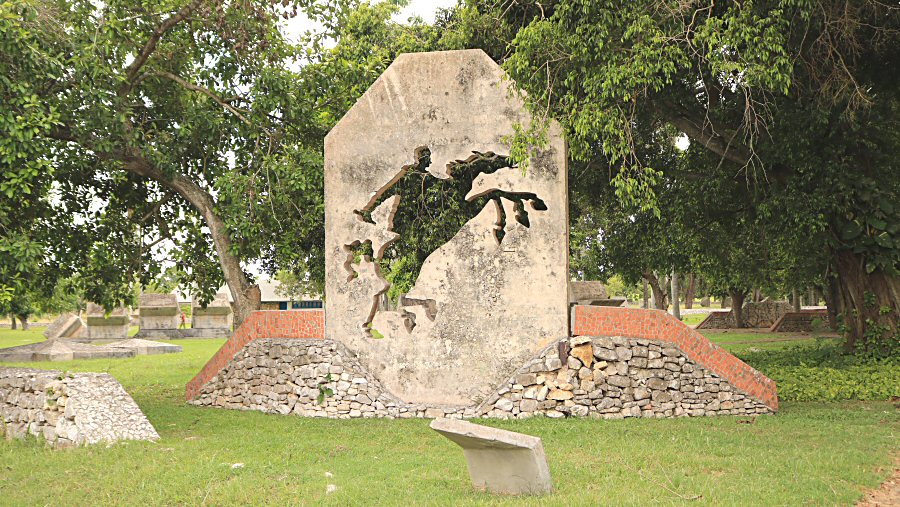
The road from San Pedro to Cacahual, the final resting place of
Maceo and Toro, is full of symbolic meaning for Cubans. The
so-called Antonio Maceo Monument Complex includes the site where
fell (San Pedro), the site used by Antonio Maceo as his
headquarters during the Battle of San Pedro (Montiel Estate),
the site where Maceo and Francisco Gómez Toro were martyred
(Monument to Maceo in Bobadillo quarter), the site where their
bodies were smuggled from the Spanish and hidden overnight (Pozo
de Lombillo), and the burial sites (El Cacahual).
All of these sites, spread over a vast area, are necessary to visit to commemorate the brave people who sacrificed themselves.
COMPLEJO MONUMENTARIO DE SAN PEDRO DE PUNTA BRAVA
In 1919, a six-meter-high concrete monolith was built on Bobadilla quarter, on the exact spot, where Antonio Maceo and Francisco Gómez Toro fell in 1896. It was topped by a bust of Maceo. It was the work of the Spanish sculptor Ramón Mateo. On one side of the monolith was a glass urn, containing the wooden cross made of yaba wood that Máximo Gómez placed at the spot where Antonio Maceo fell in combat, in 1899. On the other side was the relief that reflected the image of Maceo and Toro in the Battle of San Pedro.
Later, especially after the 1950s, it was decided to build a complex of monuments in memory of Antonio Maceo, encompassing all the locations and details related to his death. For this reason, the monolith was removed from its location, and the glass urn and the relief were transferred to the museum to be exhibited, which opened on the same site.
The memorial site, located in the Bobadilla quarter, where Maceo and Toro fell in the battle of San Pedro, constitutes a significant portion of the Antonio Maceo Monument Complex which should be visited as the first stage.
It's a rather solemn and calm place. The monumental area, arranged as an open area, greets visitors at the entrance with the very popular image of Maceo on his rearing horse. Along the way you will see the images of prominent figures who participated in the Battle of San Pedro, carved in stone. Some stone carvings accompany the path leading to the green area, reflect the heroism of the mambis in battle, are rather very interesting.
On the exact spot where Antonio Maceo and Francisco Gómez Toro fell in 1896, there stands two gigantic star-shaped concrete structures. The large one is dedicated to Maceo (tall like him) and the smaller one to Toro. Both have the inside painted in the shape of the Cuban flag.
A tiled design in front of a life-sized star depicts two slain heroes. A plaque in this area reads: "General Antonio Maceo fell at this spot. His companions tried several times to carry his body away. Once again, his aide, Panchito Gomez Toro, was killed with machetes. His bodies were rescued at the site of the monument by a small force led by Colonel Juan Delgado."
The place is overwhelmingly symbolic, recreating combat with five groups of giant stars and pyramids, like the military ranks of the mambises and Spanish. The palm trees generally represent the mambis who were killed for the sake of their homeland.
There is also an amphitheater with a capacity of one thousand people.
The museum, which has a typical appearance with its blue painted doors and windows, contains maps on which you can follow Juan Delgado's journey from the time he collected the bodies of Maceo and Toro until his arrival at the Pérez family estate, where the Pact of Silence was signed.
Also exhibited in the museum is the machete given by Máximo Gómez to Federico Hernández Hidalgo, the owner of the Bobadilla estate, as a gift. Some panels on the walls illustrate the sea crossing of the Mariel – Majana military trail. There are also personal belongings of several mambi leaders, a facsimile document from the newspaper La Lucha with the news informing the death of Antonio Maceo, a copy of the letter that was given to all those who participated in the exhumation of the bodies of Maceo and his assistant, bloody remains of the T-shirt that Maceo was wearing at the time of his fall in combat and a model of the monumental area. The bronze bust of the hero and the bronze relief, both from the first monolith erected by Spanish sculptor Ramón Mateo, are also on display at the museum.
Every December 7th, the Monument to Maceo becomes the starting point for the pilgrimage known as the March of the Generals, which arrives in Cacahual and is attended by individuals and institutions from the provinces of Artemisa, Havana, and Mayabeque.
All of these sites, spread over a vast area, are necessary to visit to commemorate the brave people who sacrificed themselves.
COMPLEJO MONUMENTARIO DE SAN PEDRO DE PUNTA BRAVA
In 1919, a six-meter-high concrete monolith was built on Bobadilla quarter, on the exact spot, where Antonio Maceo and Francisco Gómez Toro fell in 1896. It was topped by a bust of Maceo. It was the work of the Spanish sculptor Ramón Mateo. On one side of the monolith was a glass urn, containing the wooden cross made of yaba wood that Máximo Gómez placed at the spot where Antonio Maceo fell in combat, in 1899. On the other side was the relief that reflected the image of Maceo and Toro in the Battle of San Pedro.
Later, especially after the 1950s, it was decided to build a complex of monuments in memory of Antonio Maceo, encompassing all the locations and details related to his death. For this reason, the monolith was removed from its location, and the glass urn and the relief were transferred to the museum to be exhibited, which opened on the same site.
The memorial site, located in the Bobadilla quarter, where Maceo and Toro fell in the battle of San Pedro, constitutes a significant portion of the Antonio Maceo Monument Complex which should be visited as the first stage.
It's a rather solemn and calm place. The monumental area, arranged as an open area, greets visitors at the entrance with the very popular image of Maceo on his rearing horse. Along the way you will see the images of prominent figures who participated in the Battle of San Pedro, carved in stone. Some stone carvings accompany the path leading to the green area, reflect the heroism of the mambis in battle, are rather very interesting.
On the exact spot where Antonio Maceo and Francisco Gómez Toro fell in 1896, there stands two gigantic star-shaped concrete structures. The large one is dedicated to Maceo (tall like him) and the smaller one to Toro. Both have the inside painted in the shape of the Cuban flag.
A tiled design in front of a life-sized star depicts two slain heroes. A plaque in this area reads: "General Antonio Maceo fell at this spot. His companions tried several times to carry his body away. Once again, his aide, Panchito Gomez Toro, was killed with machetes. His bodies were rescued at the site of the monument by a small force led by Colonel Juan Delgado."
The place is overwhelmingly symbolic, recreating combat with five groups of giant stars and pyramids, like the military ranks of the mambises and Spanish. The palm trees generally represent the mambis who were killed for the sake of their homeland.
There is also an amphitheater with a capacity of one thousand people.
The museum, which has a typical appearance with its blue painted doors and windows, contains maps on which you can follow Juan Delgado's journey from the time he collected the bodies of Maceo and Toro until his arrival at the Pérez family estate, where the Pact of Silence was signed.
Also exhibited in the museum is the machete given by Máximo Gómez to Federico Hernández Hidalgo, the owner of the Bobadilla estate, as a gift. Some panels on the walls illustrate the sea crossing of the Mariel – Majana military trail. There are also personal belongings of several mambi leaders, a facsimile document from the newspaper La Lucha with the news informing the death of Antonio Maceo, a copy of the letter that was given to all those who participated in the exhumation of the bodies of Maceo and his assistant, bloody remains of the T-shirt that Maceo was wearing at the time of his fall in combat and a model of the monumental area. The bronze bust of the hero and the bronze relief, both from the first monolith erected by Spanish sculptor Ramón Mateo, are also on display at the museum.
Every December 7th, the Monument to Maceo becomes the starting point for the pilgrimage known as the March of the Generals, which arrives in Cacahual and is attended by individuals and institutions from the provinces of Artemisa, Havana, and Mayabeque.
